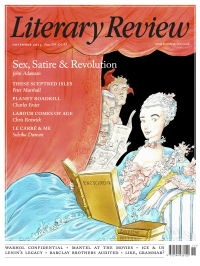Peter Davidson
When Mauve Was the New Black
Colour Revolution: Victorian Art, Fashion and Design
Ashmolean Museum, Oxford, until 18 February 2024
As the narrative of Virginia Woolf’s Orlando moves into the 19th century, the skies cloud over and ivy flourishes, choking the windows, shutting out such light as remains and ushering in a gloomy age of monochrome conformity and mourning. As the Victorian era progressed, Ruskin grew obsessed with what he called the ‘storm cloud of the nineteenth century’, the Manchester ‘devils’ darkness’ clouding the skies and blighting the grass in his garden as it darkened his mind. Dickens set his later novels in dimmed light and grievous weather: think of the ubiquitous fog of Bleak House and the raw autumn evening of The Mystery of Edwin Drood.
But this was also the century of Pugin and Morris, of flaunting polychrome stencilling in chancels, of jewelled stained glass in east windows. Few writers in English can ever have been more aware of colour than Gerard Manley Hopkins. Hopkins’s observations of a kaleidoscopic sunset are as brilliantly saturated in colour as any Pre-Raphaelite canvas:
Orange, lowest and nearest the sundown; above this, and broader, green; above this, broader still, a variable red, ending in being crimson; above this a faint lilac. The lilac disappears; the green deepens, spreads, and encroaches on the orange; and the red deepens, spreads, and encroaches on the green, till at last one red, varying downwards from crimson to scarlet or orange fills the west and south.
The sheer complexity and variety of the 19th century’s relationship with colour is investigated with insight and wit in ‘Colour Revolution: Victorian Art, Fashion and Design’ at the Ashmolean Museum in Oxford. This is a generous and comprehensive exhibition, covering almost the whole of Victoria’s long reign from

Sign Up to our newsletter
Receive free articles, highlights from the archive, news, details of prizes, and much more.@Lit_Review
Follow Literary Review on Twitter
Twitter Feed
Literary Review is seeking an editorial intern.
Though Jean-Michel Basquiat was a sensation in his lifetime, it was thirty years after his death that one of his pieces fetched a record price of $110.5 million.
Stephen Smith explores the artist's starry afterlife.
Stephen Smith - Paint Fast, Die Young
Stephen Smith: Paint Fast, Die Young - Jean-Michel Basquiat: The Making of an Icon by Doug Woodham
literaryreview.co.uk
15th-century news transmission was a slow business, reliant on horses and ships. As the centuries passed, though, mass newspapers and faster transport sped things up.
John Adamson examines how this evolution changed Europe.
John Adamson - Hold the Front Page
John Adamson: Hold the Front Page - The Great Exchange: Making the News in Early Modern Europe by Joad Raymond Wren
literaryreview.co.uk